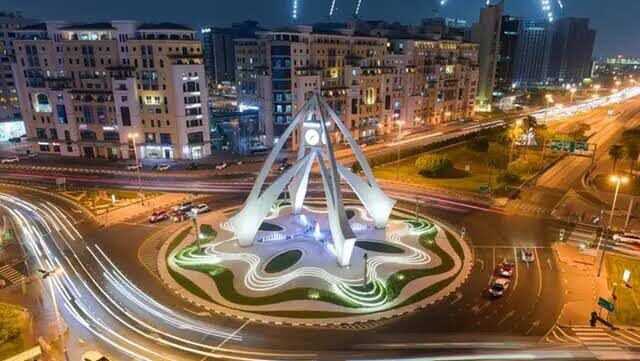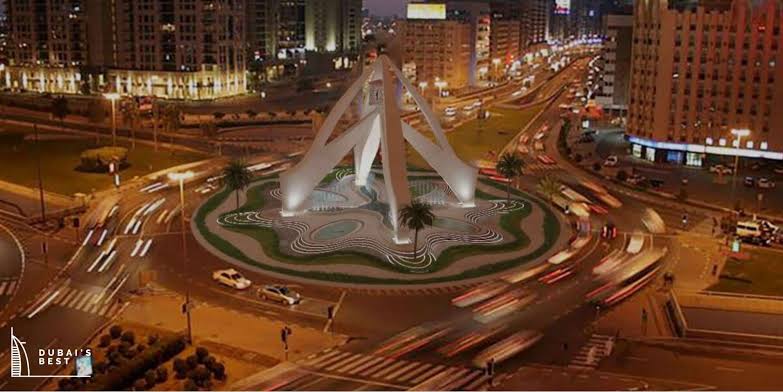Located at the bustling intersection of Al Maktoum Road and Naif Road in Dubai, the Clock Tower Roundabout has long been one of the most iconic landmarks in the city. Serving as a crucial traffic junction, this roundabout holds immense historical and cultural significance, marking Dubai’s transition from a modest trading post to a thriving metropolis. With its distinctive clock tower at the center, it has witnessed the rapid evolution of Dubai’s skyline, as well as its role as a gateway to some of the city’s most important commercial and residential areas.
This article explores the historical importance of the Clock Tower Roundabout, its symbolism in Dubai’s growth, the transformation it has undergone over the years, and the plans for its future.
The Origins of the Clock Tower Roundabout
The Clock Tower was constructed in 1963, making it one of the oldest and most recognizable structures in Dubai. The roundabout itself was created as part of the city’s efforts to improve traffic flow and infrastructure in response to the increasing urbanization and population growth of the 1960s.

At the time of its construction, Dubai was experiencing a period of significant change. The discovery of oil in the UAE during the late 1950s had brought unprecedented wealth and development to the region. This newfound prosperity led to an influx of people from all over the world, resulting in the need for modernized infrastructure, roads, and urban planning. The Clock Tower Roundabout became a central point in this transformation, connecting key areas such as Deira, Bur Dubai, and Al Rigga.
The Clock Tower itself was a gift from the British government to Dubai, a symbol of the country’s growing ties with the West. Made of steel and concrete, it was designed to blend both traditional and modern architectural elements. The clock in the tower is one of the defining features, with its large face visible to passersby from all directions, acting as a beacon in the heart of the city.

The Symbolism of the Clock Tower
The Clock Tower has always been more than just a functional timepiece; it is a symbol of Dubai’s progress and ambition. When it was built, the structure represented the city’s desire to embrace modernity and sophistication while preserving its traditional roots. Dubai, which had been primarily a port town known for its pearl diving, fishing, and trading industries, was beginning to look toward a future driven by technology, commerce, and tourism.
The Clock Tower was strategically placed at the intersection of two major roads to represent this forward-looking vision. As a timepiece, it also symbolized the city’s rapid development, as well as its strategic role as a hub for commerce and business in the Middle East. Over time, it became a focal point for residents and visitors alike, serving as a landmark that marked the passing of time amid the ever-changing cityscape.
As Dubai evolved into a global city, the Clock Tower maintained its relevance, standing as a testament to the city’s resilience and ability to innovate while honoring its past. Today, it remains a beloved symbol of the UAE’s national identity and growth.
The Role of the Clock Tower Roundabout in Dubai’s Traffic System
The Clock Tower Roundabout has been at the heart of Dubai’s transportation network for decades. Historically, roundabouts were common in Dubai as a way to manage traffic flow at busy intersections. The location of the Clock Tower, with its access to Deira, Bur Dubai, and the Dubai International Airport, made it a vital node in the city’s road network. Over the years, the roundabout became a central traffic hub, with thousands of vehicles passing through it daily.
However, as Dubai’s population and traffic volume grew, the roundabout began to experience significant congestion. The combination of a growing urban population and the city’s expanding infrastructure led to a need for modernization. As a result, in recent years, the Clock Tower Roundabout underwent a series of developments aimed at improving traffic flow and safety.
The Transformation: From Roundabout to Tunnel
In 2012, the Clock Tower Roundabout underwent a significant transformation as part of Dubai’s broader initiative to modernize its traffic infrastructure. The Dubai Roads and Transport Authority (RTA) decided to replace the roundabout with an underpass tunnel, with the goal of alleviating congestion and improving traffic flow in one of the city’s busiest intersections.
The decision to convert the roundabout into a tunnel was made to address the growing traffic demands and reduce the risks associated with the roundabout’s layout. Roundabouts, while effective in some situations, can become bottlenecks when traffic volume increases, as was the case at the Clock Tower Roundabout. The introduction of the tunnel provided a more efficient solution, allowing vehicles to move through the area with greater ease and reducing the waiting time for motorists.
The Clock Tower Tunnel was inaugurated in 2013, and it quickly became a success. The tunnel not only improved the flow of traffic but also helped reduce accidents and congestion, ensuring smoother transitions between key areas such as Deira and Bur Dubai.
While the transformation of the roundabout into a tunnel was a practical step toward managing Dubai’s growing traffic challenges, it was also done in a way that respected the Clock Tower’s place in the city’s heritage. The iconic clock tower was preserved and remains a central feature of the intersection, acting as a visual anchor amidst the modernized infrastructure.
The Clock Tower Roundabout: A Cultural Landmark
The Clock Tower’s role in Dubai extends beyond its functional aspects. It has become an integral part of the city’s identity, featured in countless images, videos, and artworks that celebrate Dubai’s rich history and rapid development. It has been captured in numerous photographs, films, and advertisements, often serving as a backdrop to depict the city’s blend of the old and the new.
As Dubai’s skyline transformed with the construction of futuristic skyscrapers like the Burj Khalifa, the Burj Al Arab, and the Dubai Marina, the Clock Tower Roundabout remained a timeless landmark, reminding residents and visitors alike of the city’s humble beginnings. The juxtaposition of the Clock Tower against Dubai’s modern skyscrapers offers a visual metaphor for the city’s remarkable growth over the decades.
The Clock Tower continues to play a significant cultural role as well. It is a favorite spot for tourists who wish to learn more about Dubai’s history. Visitors from all over the world take photographs with the clock tower as a memento of their trip, symbolizing the connection between Dubai’s past and its vibrant future.
Future Plans for the Clock Tower and Surrounding Area
Looking ahead, there are plans to further integrate the Clock Tower into the city’s ongoing development projects. While the area around the Clock Tower has already undergone significant changes in terms of infrastructure, there is a focus on enhancing its role as a cultural and heritage landmark.
The Dubai government has expressed interest in incorporating more green spaces, pedestrian walkways, and public art installations around the Clock Tower to make it more accessible and engaging for residents and tourists. As the area surrounding the clock tower continues to develop, there may be more efforts to ensure that this landmark is not only a functional part of the city’s transportation network but also a destination for cultural and community activities.
In the future, the Clock Tower could serve as a focal point for Dubai’s efforts to balance modernity with preservation, ensuring that the city’s rich cultural heritage remains an integral part of its contemporary identity.
Conclusion
The Clock Tower Roundabout has stood as a symbol of Dubai’s transformation from a small port town into a global metropolis. Through decades of change and modernization, the tower has remained a beloved landmark, a testament to the city’s remarkable growth and its commitment to honoring its history. As Dubai continues to evolve, the Clock Tower will undoubtedly remain a symbol of the city’s vision, progress, and ambition—standing tall amidst the shifting landscape of one of the world’s most dynamic cities. Whether as a traffic junction or a cultural beacon, the Clock Tower will always hold a special place in the hearts of those who call Dubai home.
Do follow Uae stories for more Updates













